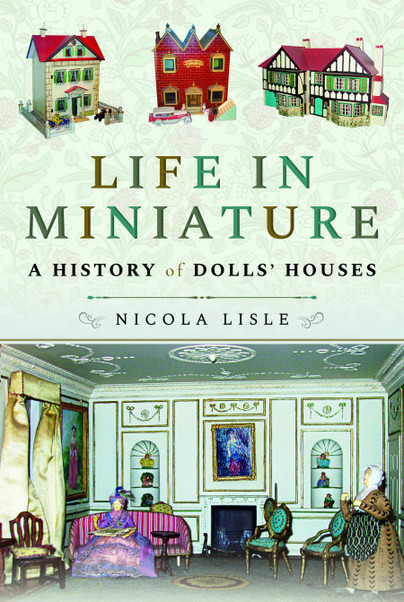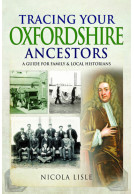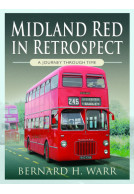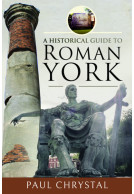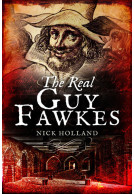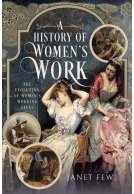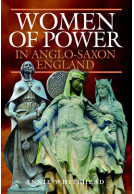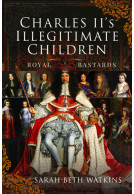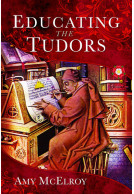Life in Miniature (Paperback)
A History of Dolls' Houses
Imprint: Pen & Sword History
Pages: 208
Illustrations: 40 colour illustrations
ISBN: 9781526797049
Published: 15th November 2021
Last Released: 6th October 2022
Blog tour
A Q&A with the author via the History... the Interesting Bits blog.
(click here for international delivery rates)
Need a currency converter? Check XE.com for live rates
| Other formats available | Price |
|---|---|
| Life in Miniature ePub (30.8 MB) Add to Basket | £6.99 |
Popular in Britain since the late seventeenth century, dolls’ houses are tiny slices of social history that give us a fascinating glimpse into domestic life over the last 300 years.
In this beautifully-illustrated book, Nicola Lisle explores the origins and history of dolls’ houses and their furnishings, from the earliest known dolls’ house in sixteenth century Bavaria to the present, and looks at how they reflect the architecture, fashions, social attitudes, innovations and craftsmanship of their day. She discusses the changing role of dolls’ houses and highlights significant events and people to give historical context. She also takes a look at some of the leading dolls’ house manufacturers, such as Silber & Fleming and Lines Brothers Ltd (later Triang).
The book includes numerous examples of interesting dolls’ houses, the stories behind them and where to see them. This includes famous models such as Queen Mary’s spectacular 1920s dolls’ house at Windsor Castle and the eighteenth-century baby house at Kew Palace.
There is also a chapter on model towns and villages, which became popular in the twentieth century and also give us a window on the past by replicating real places or capturing scenes typical of a bygone era, as well as advice for dolls’ house collectors, a detailed directory of places to visit and recommended further reading.
One of the most comprehensive guides available on the subject published in recent years, this book offers unique insights into the world of dolls’ houses and is a must for anyone with an interest in the history and appeal of these miniature treasures.
One of the most comprehensive guides available on the subject, this book offers unique insights into the world of dolls’ houses and is a must for anyone with an interest in the history and appeal of these miniature treasures.
Author Translator
Read the full review here
I have been interested in the history of dolls’ houses since learning of Petronella Oortman’s dolls’ house in an undergraduate Art History course, so I was delighted to find this brief but information-packed book.
NetGalley, Samantha Edelman
Beginning with the typically instructional baby houses of the sixteenth century and moving forward in time, Nicola Lisle gives us just the right amount of detail on the medium, using both contextual and object-based perspective.
Of particular interest are the sections on dolls cabinets of the Dutch Golden Age and the shift in purpose of dolls’ houses (most notable in the Victorian Era), but the text is a fascinating read throughout.
As featured in
Family Tree
As featured in
Evergreen
As featured in
Evergreen
This book really appealed to me because like books, dollhouses, and miniatures are worlds within worlds. In my reading life, I love how they can be used to be clues in mysteries, oracles of unfortunate events, a place of escape and aesthetics, and of course creepy and threatening. All of this I love but I don't really know about the true origins of the miniatures or how they have evolved therefore this book filled in all of those gaps.
NetGalley, Zoe Pollock
I really enjoyed reading about the history, how the miniatures started as learning tools and evolved into what we know of the dollhouses today. I also liked how the author Lisle invites us into her world and love of miniatures. You can read her passion within her words.
Rating: 5 out of 5 stars
NetGalley, Mary Hess
This well researched and gracefully written study of dolls' houses from the earliest models meant to display the wealth of the owner in carefully crafted miniatures to today’s mass manufactured toys is a comprehensive and entertaining study for both the collector and the casual reader. As social history, its range is impressive and the author’s observations are insightful; scholarly, but not dull. The dolls’ house deserves a thoughtful history and this is an excellent source, with copious illustrations and extensive source materials. . The focus is on the UK, but readers everywhere will enjoy the descriptions of 17th c royal “baby houses” and the evolution of modern children’s toys. What began as an adult hobby of the very rich migrated to a tool to teach little girls housekeeping skills in miniature. The Victorian era was the moment in the development of this hobby that democratized the dolls’ house. Today many children inherit a dolls house: in my family the dolls' house made for me by my grandfather was played with by my sisters and my niece, who will probably pass it on to her daughter. Dolls and miniature furniture, themselves an active and popular hobby, are also discussed, as are the phenomenon of miniature villages.
Doll Houses have a long, interesting history and Lisle goes in depth about their history, illustrating trends throughout the years, who owned them and concludes with advice for people considering starting a doll house collection.
NetGalley, Jenny Bradford
I loved this book. I had no idea that dolls houses could be so useful to historians - I'd always just viewed them as toys to be honest. This book changed all that and made me see that they can be a very revealing record of social and political history with the types of decor, cars and even books on the tiny bookshelves. The history of the doll's house and its uses was really interesting, originally for grown ups to entertain and show off!
NetGalley, Jo Romero
As featured on Lil's Vintage World
Lil's Vintage World
Article ‘Exploring Derbyshire’s Miniature Worlds’ as featured by
Reflections, January 2021
I don’t think I can recommend enough Life in Miniature by Nicola Lisle – A History of Dolls’ Houses. I loved it! It was such a fascinating book. I had no idea, before reading the book, how widespread the doll houses were before the Victorian era. Lisle talks about doll houses in Britain and also abroad, which is so interesting. 5/5 stars
Coffee and Books
Read the full review here
Nicola's history of dolls' houses is both comprehensive and enjoyable. It's a hobby primarily enjoyed by girls, I guess, but it's fascinating for just about anyone!
Books Monthly
Reading this book has been a true delight, and I learnt to appreciate something that I never knew had much value. Thoroughly recommend!
Natalie is a History Buff
Read the full review here
This book is an absolute delight, packed full of interesting facts and figures and a selection of truly amazing photographs – it’s worth it just for the pictures alone, in my opinion but of course there is so much more besides those.
Daisy Says
Read the full review here
Life in Miniature looks back through the history of these tiny houses in detail and helps the reader understand how they're important to us as historians. As well as discussing their use and purpose, we learn about examples across Europe and in the UK that are delicately housed in museums and stately homes, quite often in archives under lock and key. At the back of the book there is a list of the dolls' houses that you can visit which is really useful as once you've read the book, you honestly can't wait to go out and find the nearest dolls house you can, to see what you can learn from it.
Love British History
If you're interested in history, this book is a really good read, and not only if you like the history of toys or play. It'll give you an insight into analysing these miniature buildings for clues about the past, whether social or political and you'll appreciate them as snapshots of life frozen in time.
Read the full review here
Nicola Lisle's book is an extremely interesting journey into a world that is affected by the passion of children and adults. Often a passion that lasts a lifetime, for many who have tried it. In the end, every dolls' house encountered has its own life and often changes with the years and with the various owners who take turns, each house is a mirror of the child who played with it and the adult who kept it. Itself is also a journey into the uses and customs of the past and as such has a recognized and protected historical value, a value that goes beyond the economic aspect. At the same time the dolls'house continues to hold its own as a game even today, in a world of video games and mobile phones, and this is an enormously positive thing because the fantasy (the same fantasy of the little Lena Montgomery of Stanbrig Eorls, 120 years ago) that stimulates itself with play should not be caged.
On The Old Barbed Wire
Read the full Italian review here
Life in Miniature: A History of Dolls' Houses by Nicola Lisle is a fascinating history which includes a section of photographs that are wonderful.
NetGalley, Jack Messer
I'll start by stating that I came to this with little knowledge of dolls' houses but an interest in knowing how and why they came to be. Even though I knew of a few of the houses that served as social statements in the past I did have the mistaken impression that they were always for children and those examples were the exception. I was wrong. They developed into children's objects when production became less expensive and painstaking.
As a history this book combines just enough context for the various time periods so the reader can understand why these houses carried the meaning(s) they did. I spent a small amount of time searching online for additional images, which was a fun task in itself. But it also highlights what would, for me, have made this a phenomenal book: more photographs and even drawings. That is a bit of an unfair complaint since this is not promoted as a coffee table book, I just happen to think it would have made for a beautiful one.
As a reader and lit person, I especially enjoyed the chapter on "Doll Houses in Literature." In addition to the information contained here, it served to make me think about how so many things we now consider children's toys or objects that carry a lot of meaning in literature, film, and even music. That is off topic but I always appreciate a book that sends me off on a related tangent, it means the book has successfully engaged me.
I highly recommend this to anyone already interested in dolls' houses as well as those like myself who simply want to learn the history of something we're all familiar with.
Rating: 5 out of 5 stars
NetGalley, Rachel Rappaport
I am not a dollhouse maker myself but I really enjoy seeing them! I made a special trip to Windsor to see the famous one there and have been to dollhouse shows in museums closer to home. This book gave me a greater appreciation for the history and craftsmanship of dollhouses and their importance in our culture.
Rating: 5 out of 5 stars
NetGalley, Teresa Grabs
Few things are more fascinating than doll houses. Lisle presents the history of doll houses in a fantastic and enjoyable way as we journey through time and across countries to see how this wonderful tiny houses came to be. This is a must have for any collector.
Rating: 5 out of 5 stars
NetGalley, Julia Simpson-Urrutia
I love dollhouses and I was all prepared to love this book, but I went a step beyond and seriously adore it. The chapter titles were the first addiction . . .historical content with fascinating themes and an explanation for the development of doll houses in general. The German "baby houses," as they were called in the 16th century (I had no idea, fascinating!) owe a lot to Duke Albert V who commissioned a team of craftsmen to create and furnish the Munich Baby House, possibly intended for his daughters Maria Anna and Maximiliana Maria, who were around 5 and 6 years old. This is the kind of stuff one does not come across, sadly, in the novels about that era. I have seen scant references to dolls, and even less to doll houses, but one assumes children wanted to play and people have always been fascinated by miniatures. Some of the content made me think of The Miniaturist because of the idea that (naturally) doll houses started out as being for the wealthy and were not considered toys but status items. Now with this pandemic, I have been thinking more and more of getting back to my fascination with doll houses and this book is truly inspiring, for it explains architecture and culture while talking about one of my favorite subjects. Ann Sharp, the little daughter of the Archbishop of York, is the subject of an entire chapter that talks about her baby house which was probably made somewhere between 1695 and 1700. I must have seen the miniature model houses at Hever Castle, but the mere mention sent me into a tizzy. Thank God for the pictures at the end of the book. Caution: you will want the print edition. Delightful indeed are the chapters about dolls' houses in literature, the names of model villages, abundant information about notable doll house collectors and places to visit, primarily in the U.K and good heavens, doll house fairs and festivals. I need this book in print. Last but not least are web links and email addresses. Fabulous!
I loved this book on a personal level since I enjoy dollhouses and miniatures. The history was so interesting and I look forward to sharing it with other hobbyists.
NetGalley, Victoria Peipert
I love a good microhistory. This is a thorough look at dolls houses, including how they developed over time, outstanding examples of surviving dolls houses, and stories about collectors and makers. I found the first section a bit dry at times, but for someone who is into miniatures, it'd be a goldmine. I loved the section reviewing dolls houses in fiction and appreciate the substantial appendix of where to see dolls houses and where to look online or at the library to find out more. A wonderfully researched history that will be well loved.
NetGalley, Lauren MN
This was a short but enjoyable read that adds color and spark to historical objects I wouldn't normally pay much mind and for that it's a read I very much enjoyed.
NetGalley, Sarah Stewart
I have always been interested in dollhouses, but I had no idea about the history of them.
NetGalley, Jeanne Schutts
This book has a lot of detail on how the purposes of baby houses (dollhouses) evolved over the centuries as well as detailed descriptions of numerous houses.
There is an appendix with an extensive list of places to visit along with addresses, email, phone numbers, and websites.
Such a charming and informative book, about a subject I've never read in any depth before - dolls' houses. I learnt a lot, and very much enjoyed this.
NetGalley, Kirsty H
I didn't know anything at all about dolls' houses, and I feel like this was a very good short introduction to the theme! The book has a chapter about dolls' houses in literature, has a short guide on collecting (deciding what you want, where to find, different types of houses), followed by a chapter with "some notable collectors".
NetGalley, Giovana Mazzoni
There is a long appendix with suggestions of places to visit (all in Europe, I believe), and also a list of books for further reading, including in that non-fiction (about history of these houses), fiction, magazines, and even websites.
Overall, I really enjoyed this! It was really interesting to see the changes in the houses themselves and the way the families interacted with them.
This book is a little delight. I'd never given much thought to dolls' houses before, except maybe the Sylvanian families line. But as it turns out, dolls' houses have a lot of historical value. Lisle takes us to the earliest known "baby houses" all the way to the present day.
NetGalley, Patricia J
The houses are usually more than toys. Often, they were never intended as such! Small, coquette recreations of real counterparts, these doll houses give us a glimpse of the past and the luxury spent on making a version of home small enough to appreciate in one go. And of course, there was a show-off element. By the 1920s, some dolls' houses were positively marketing tools! The portion dedicated to Queen Mary's Dolls' House from the British Empire Exhibition of Arts and Manufacturing is a visual feast for the mind, with its endless list of miniature contributions from contemporary craftsmen like Rolls Royce, Thomas Hardy, A.A. Milne, Gustav Holst, Dame Laura Knight, Edmund Dulac, etc. They even had little dolls' tennis rackets made by Alfred Doncaster, purveyor of rackets to the Wimbledon stars.
I especially loved the history of dolls' house manufacturing that Lisle gives throughout, including home-made versions from the WWII "make-do and mend" period. I could swear items made form matchboxes and safety pins came straight out of Mary Norton's "The Borrowers"! It's a far cry from the Chippendale and Palladian recreations, at any rate.
If your interest is piqued (as mine as), then you'll enjoy Nicola Lisle's handy guides at the back of the book: one on how to start your own collection, and another (more my cup of tea) on the museums lucky enough to keep these little houses safe and sound for the public's enjoyment.
Recommended for anyone with an interest in miniature slices of domestic history.
Rating: 5 out of 5 stars
NetGalley, Dawn Lewis
I don't know what it is that makes dolls' houses (and miniatures in general) so appealing, but there's no doubt that a large proportion of the population has a positive response to them. This book is perfect for anyone slightly fascinated, enthusiastic, or obsessed! The photos are a beautiful addition. There's a handy buying guide included... you know... just in case! "Life in Miniature" is a wonderful book - maybe almost as good as actually owning a dolls' house!
When I was young, I always wanted a doll house although that dream was not realized. I did enjoy seeing a number of doll houses in museums and was always intrigued by the houses and their small furnishings. When my kids were young, there was a wonderful doll house store near where I worked and we loved going there.
NetGalley, Joyce Laudon
So, based on all of that, I was excited to see this title on dollhouses. It is clear that the author loves her subject.
This title takes an academic, but by no means dry, approach providing a great deal of history starting from the earliest houses in the sixteenth century when they were not children’s playthings. That you will learn began more around Victorian times. Just a few of the intriguing chapter headings include Ann Sharp’s Baby House, Dolls’ Houses in Literature and Miniatures Move Outside: Model Towns and Villages. There are, additionally, an appendices; on includes places to visit while the other is offers suggestions for further reading.
This book is full of information and includes some lovely illustrations. The audience that this book was written for should very much enjoy this title.
This was a fascinating and enjoyable read that takes the reader through the history of baby houses in Britain. For a non-fiction guide, rich in history, it reads with ease while teaching an amazing amount of information regarding baby houses.
NetGalley, Alexis Turner
The historical role of baby houses as educational tools, entertainment and displays of wealth is fully explored. The anecdotes provide a fascinating view into the past with the baby houses encapsulating a snapshot of each era. The author’s love of the subject matter shows in the writing and the expertise shared makes this a must read for anyone interested in the world of miniatures, model villages or the history of toys.
Rating: 5 out of 5 stars
NetGalley, Brenda Carleton
Detailing everything one could possibly wish to learn about miniatures, this splendid book examines multitudinous examples of doll (baby) houses and their creators and owners as well as miniature villages throughout time from the 16th century Germany to the present. These miniatures are very important to us historically as they were often created in various eras of that particular time period, showing us personal slivers of what life was like, upstairs and downstairs. Of course some are created in the present denoting the past, too.
This book increased my knowledge on the subject exponentially. Though these intricate baby (small) houses were often designed for play they were also designed to educate children (mainly girls) in how to run a household as well as ways to display fabulous wealth. The latter cabinets were stored under lock and key as they often held valuable antiques and treasures.
I've been fortunate to visit some of the baby houses and am always amazed at the exquisite craftsmanship of the furnishings and meticulous details from baking food to toys to working electricity to table settings. My dad made us girls a doll house and it inspired my passion for miniatures.
I love that this book provides insight to those who owned these baby houses and later donated them so others could enjoy them. Also helpful is the long list of places one can visit as well as websites for further research (which has whet my appetite and prompted me to find out more). Not only that but this book also contains practical information on how to go about collecting.
Photographs are also included which really bring history to life. Beautifully done.
Those with any level of interest in miniatures would find this book fascinating, educational and useful. Highly recommended.
This was a wonderful little read. I had a doll house growing up that my grandfather made for me. It was so neat and beautiful. We played with it and bought lots of furniture. Then while my family was in England we got to see Queen Mary’s dolls’ house. I was very interested to learn about the cabinet houses. I had never heard of anything like them but they were beautiful. And the fact that they were made for adults! I can see where the appeal is though.
NetGalley, Ashley Pohlenz
It was fun to read about how they didn't even start out as a children's toy (that came later, in the 19th century). A well-researched read for anyone who cares about dollhouses.
NetGalley, Erin Childs
About Nicola Lisle
Nicola Lisle is a freelance journalist and author specialising in history and the arts. She has written numerous articles for family history magazines, including Who Do You Think You Are?, Your Family History and Discover Your Ancestors, and was a regular contributor to Dolls House and Miniature Scene magazine for many years. She is the author of Tracing Your Family History Made Easy (Which? Books, 2011) and Tracing Your Oxfordshire Ancestors (Pen & Sword, 2018).







